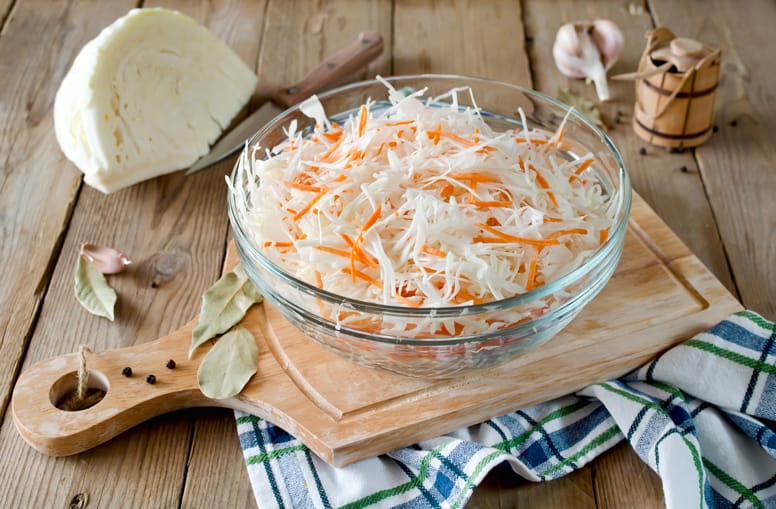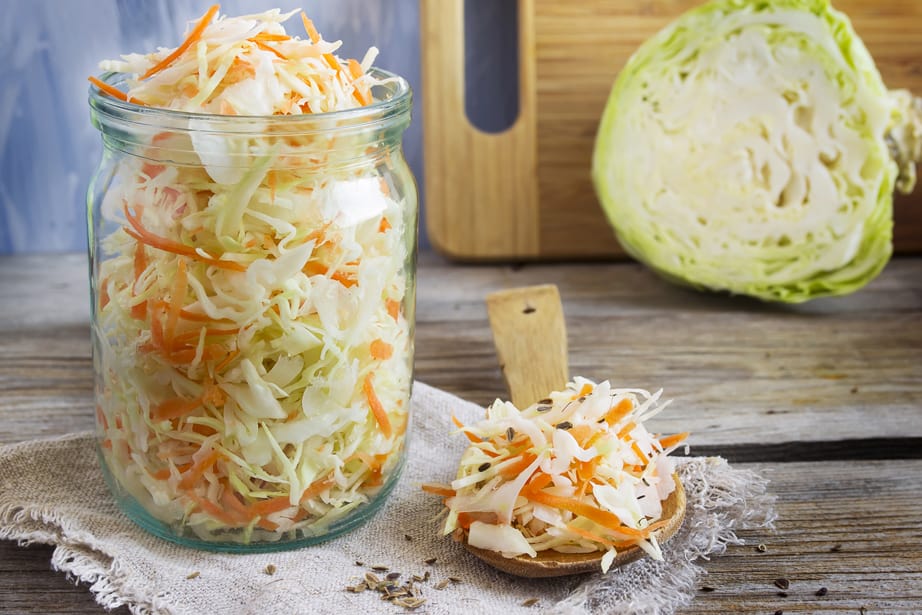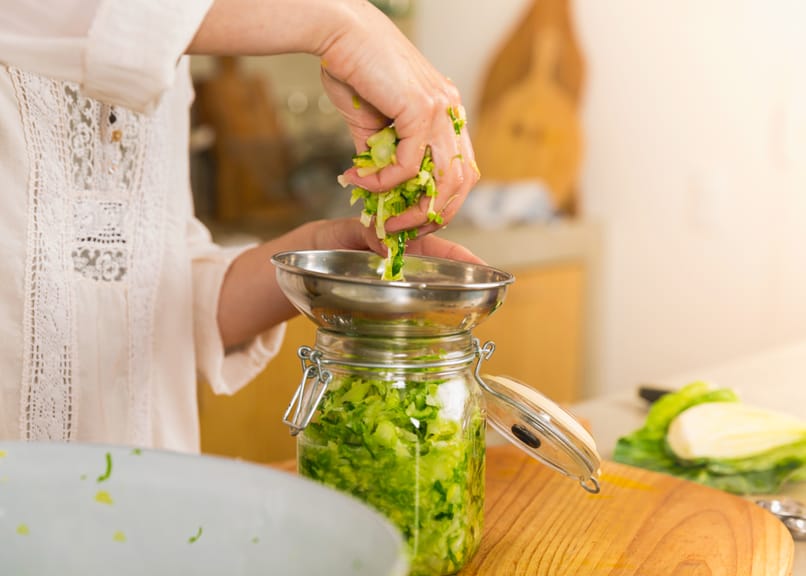![How Long to Ferment Sauerkraut [Detailed Explanation]](https://myfermentedfoods.com/wp-content/uploads/2020/04/2-4.jpg)
The art of fermentation is as easy as chopping vegetables and adding brine.
And waiting. Lots of waiting.
The process teaches us patience. It teaches us that ‘good things come to those who wait’.
The very fact that you’ve decided to ferment your food means that you are empowering yourself and your loved ones. You are saying no to unhealthy, fast foods and yes to food that has been around for centuries.
It also means saying yes to probiotics and healthy enzymes that are so incredibly good for our body that they can even fight deadly diseases.
This entire website is intended to be used as a roadmap to help you ferment your veggies with confidence. I hope to show you that being flexible and exploratory at the same time will help you get increased pleasure and health out of your foods.
Most of all, I want to help you see how much fun it is to ferment your vegetables.
In this guide, we will be covering the crucial aspect of the time required for fermentation. I get so many questions from my readers asking me about how long to ferment the sauerkraut and the different times of fermentation when we use different methods, recipes, ingredients, and vessels for fermenting.
So let’s dive right into the FAQs.

How to tell when my Sauerkraut is ready?
In its simplest form, Sauerkraut is made by shredding organic cabbage into shreds or slices which are then salted liberally and packed into clean crocks or vats.
The shredded cabbage is submerged in its brine (salty water and juices that are secreted when we add salt to the vegetables) and weighed down using ceramic/glass weights or plastic sheets weighed down with water. Traditionally, sauerkraut is fermented for up to 4 weeks.
Naturally, many factors play a role in the fermentation process. Ambient temperature is a crucial factor and you need to ensure a warm ambient temperature of about 71°F or 21 degrees °C to produce desirable acidity in the ferment.
Cabbage packed into crocks or vats at temperatures of 10-21°C (or between 50 and 70°F) ferments slowly but also retains its color, flavor, and its quality characteristics over longer storage period, as compared to that packed at higher fermentation temperatures. Cabbage packed at 4 to 10°C (40 to 50°F) ferments more slowly.
To tell if your sauerkraut is ready, you must use your sense of smell, sense of taste, and sense of sight (remember: that’s what our ancestors used. They didn’t have fancy equipment).
Your cabbage should smell fermented without being offensive. It should retain it’s white, green, fresh color and not appear pink, grey, black, or moldy.
Yes, there may be some fuzzy mold on the top of the brine, but you can simply remove it and the ferment below should still look and taste good.
You can also use pH strips to check the acidity of the ferment. Fermentation is considered complete when the pH of sauerkraut reaches an acidity of 3.8 to 3.9.
How long to ferment sauerkraut for probiotics?
One of the main reasons why sauerkraut is so healthy is due to the presence of friendly bacteria or ‘probiotic’ bacteria in it. Probiotic means ‘for life’. So, explained simply, these bacteria support life itself.
Even before you ferment cabbage, it contains friendly bacteria. Cabbage and other cruciferous vegetables like broccoli and cauliflower are proven to support natural human intestinal microflora. Cabbage contains probiotic lactobacilli which impede the growth of bad, harmful or disease-causing bacteria.
When you shred cabbage and add salt to it to make sauerkraut, you also have to crush and pound the cabbage. This step helps in secretion of its natural juices. This raw, acetified cabbage juice is rich in lactic acid and that helps kick-start the fermentation.
Thus, probiotics are already present in the cabbage in small amounts, even before it changes into kraut. When you leave the cabbage in an anaerobic environment (without oxygen), at a warm temperature for up to 4 weeks, the beneficial bacteria multiply further. They impart a great taste and flavor and also enhance the health benefits of cabbage.
You can transfer the kraut to smaller jars and place them in the refrigerator. And even in this cool environment, the wild fermentation continues, albeit at a slower rate.
So, the colonies of good or probiotic bacteria in cabbage continue to increase. Fermentation never really stops and it will continue till the very end until you finish the batch of sauerkraut.
The only difference is that the rate will greatly slow down. Also, the longer you let your cabbage ferment, the soggier it will get. Thus, the appearance, texture, and the taste of your cabbage will change as it sits and ferments longer. The older the kraut, the tangier, tarter, mushier and softer it will be.

Can you ferment sauerkraut for too long?
Yes, there is such a thing as too-long fermentation. A clear sign that you have left your cabbage out for too long a period is that it might turn mushy.
However, that is not the only factor to know for sure. As stated before, other factors also affect the rate of fermentation. If you haven’t salted your veggies adequately, then the texture can still be mushy.
Also, a too high fermentation temperature can change the texture from crispy to mushy and limp.
In summer months or warmer climates, fermenting for too long can lead to an unpleasant, acrid, and vinegary taste. You may have to rinse the kraut under running water before consuming it to reduce the acidic, sour taste.
How long should I ferment my sauerkraut in a crock?
Ideally, allow the fermentation to take place in the crock for about 2-3 weeks. During this period, do not disturb the crock or open or move it.
Make sure that you maintain an ambient temperature of at least 59°F or 15°C. Your cabbage will be ready for consumption in about 2 weeks.
You can taste your cabbage and if necessary, leave the crock out for a few more days. Watch out for the formation of mold during this period. The kraut should not turn pink, green, or grayish-black. If this occurs, discard the kraut right away.
You can also check out my guide on ‘How to make sauerkraut in a crock’. There, I have given a detailed recipe for making sauerkraut in crocks along with the best crocks to buy.
Crocks have many benefits in that; they come with fermentation weights that help you press down the kraut deep into the brine.
Crocks also come with a water channel or a moat that, when filled with water, seals the ferment from dust, flies, and microbes and also keeps out air from entering into the crock.
The channel also releases built-up gases that form during fermentation, and this helps prevent undesirable molds from forming on top.

How long to ferment vegetables?
Most vegetables like cucumbers, beans, and beets are ready within 2-3 weeks. You can taste the vegetables to check the texture and flavor.
If they are not sour or tart enough to your liking, you can keep them for a few more days before transferring them to the refrigerator.
In summer months, do not ferment too long. If you leave your kimchi, sauerkraut, or other ferments outside for too long when the ambient temperature is very warm, then you might nearly gag from the vinegar overload.
But even if that occurs, all is not lost. You can save the batch by washing it with plain water to remove the excess sour brine. The remaining kraut can then be salvaged by adding to stews, soups, broths, and other sauerkraut recipes. Check out some delicious ways to use sauerkraut.
Conclusion
How long to ferment sauerkraut is a question many people ask when they are new to fermenting foods. The fact is: there is no definite answer.
Some people love their kraut the very next day! Yes, some people eat 24-hour fermented kraut and are perfectly happy with its texture and sourness.
Traditionally though, sauerkraut needs to be fermented for at least 21 days or 3 weeks. Let your taste buds, nose, and eyes be your guide. Does the kraut look fresh and edible? Does it smell fresh and edible? Is its taste to your liking? All these answers can help you determine if the fermentation is adequate.
In summer months, when ambient temperature is high, do not let the kraut sit outside for far too long. That will lead to a mushy, acrid, vinegar-like taste. The batch could also turn moldy, pink, or gray and you’d be left with no choice but to toss it out.
In winter, you can safely consider fermenting for a week up to three weeks. You can make use of pH strips to check the acidity of the ferment. Fermentation is considered complete when the pH of sauerkraut reaches an acidity of 3.8 to 3.9.
Have fun making your kraut. Very soon you will be a pro!
Related posts
Guide to Choosing the Best Fermentation Crock

Hi Gigi, new to making sauerkraut. do i add any water all or just salt to the cabbage and bash it a bit for some brine?
Hi Lecresha, you just add salt to the sliced cabbage and keep massaging and squeezing it until it becomes softer and juice comes out. Here is the full recipe: https://myfermentedfoods.com/how-make-sauerkraut/. I hope you enjoy it.:-)
Hi there! If I find it too salty and rinsed before consuming (once it reached the right fermentation point) will I lose the probiotic benefits or will they remain? So thankful, Gaby
Hey Gaby, it might lose some, most will be fine.
Hi, kraut has been fermenting for 2.5 weeks now. Just cleaned the growth off the top and tasted the product. It is nice and crispy, the brine is brownish, and no tart taste, just salty basically. Do you think we are still good? Just need to wait longer? Thanks…
I just made my first quart of sauerkraut. I let it ferment for 10 days, then got panicky because it didn’t appear to be doing anything–no air bubbles, no mold, no kahm yeast, no sign of activity. I removed the weight, screwed on the lid, and refrigerated it. We ate some last night with dinner. I used red cabbage (supposedly more nutritious). It had turned a bright, gorgeous ruby color. It is very crunchy and quite salty but not very sour. Should I have let it ferment longer?
I got my question answered by the sauerkraut itself. The longer it sits in the fridge (almost a week now), the less salty and more mellowly sour it seems to become. It is delicious, and I love the bright ruby-red color! We have been enjoying it with dinner every night. I’ll be making another batch of red sauerkraut when this one is gone and will try for a longer ferment.
Hey Shary, great to see that you have figured it out and thanks for providing an update!
To keep up with messages, I’ve started a community for fermenters. You can join us here https://community.myfermentedfoods.com/
If I miss a message next time, another fermenter might jump in to help 😉